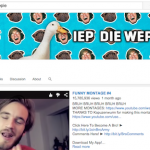
So You Want To Be A Video Blogger?
Today I have an interview with one of biggest stars of Video Blogging – Gideon Shalwick of RapidVideoBlogging.com and Become a Blogger. Gideon teaches aspiring video bloggers (like me) how to be better video bloggers.
You will have noticed that recently I have started to do some video blogging – and the remarkable thing I have found is just how ‘NATURAL” blogging on video feels to me. I say this in particular because less than 12 months ago I would not have thought of Video as being a blogging medium for me but as I have discovered many times in my life some of the things you ‘fear’ the most turn out to be the things you enjoy the most.
I accept that for some Video Blogging will never feel that natural but I would encourage you to at least give it a try. One of the big advantages of being a Video Blogger is that you don’t have to be Tom Cruise to succeed at it. Indeed it appears that the more you are ‘yourself’ and the more authentic you are the better your videos are received.
Gideon shares so many Golden Nuggets of information in this interview, I don’t really know where to start. Indeed, I’d say Gideon is one of my most generous interviewees ever – he gives away a ton of amazing information here for free. One of the things Gideon discusses is creating a:
Video Domination Hub
According to Gideon a Video Domination Hub is a YouTube channel linked with your video blog. And a video blog is just a normal blog with your YouTube videos on it (along with transcripts if you really want to do it right). You use YouTube for traffic, credibility, and exposure and you use your video blog for capturing the traffic. Then, you use a list building mechanism like AWeber on your blog to build your email list. Gideon is shortly releasing a report on this at RapidVideoBlogging.com which I encourage you to get.
There is also the other point about going for QUALITY over QUANTITY. It doesn’t take that much longer to create an exceptional video, so go for quality. Nearly one third of YouTube videos have less than 100 views and only around 10% get more than 500 views. More stats and related links at Gorumors.com
As Gideon says it is not difficult to stand out from the YouTube crowd if you are prepared to just put a little more effort into creating quality content – that people will actually get pleasure from watching. And with those stats above it is relatively easy to become a Star Video producer as well.
Listen to the Podcast or read the Interview Transcript is below – I think you will be impressed with everything Gideon has to say.
I look forward to your comments and also I’d love to hear about your own experiences with making videos – what worked for you, what did not.
And yes, I know it is a little ironic this interview is on audio and not video. Gideon is in beautiful Australia and I am in the UK (but I do hope to record some SKYPE Video calls in the near future)
To our Video Blogging Success
Michael
LISTEN TO THE FULL INTERVIEW HERE
**** Gideon Shalwick Interview Transcript ****
Michael Dunlop: Hello, everyone. This is Michael Dunlop from Income Diary, and today I’m interviewing Gideon Shalwick, who is one of the top video bloggers I know. He has a few blogs and is very well known for his site, BecomeABlogger.com, which he does with Yaro Starak. Welcome, Gideon.
Gideon Shalwick: Hey, Michael. Thanks for having me. I’m looking forward to the call and sharing whatever knowledge you’d like me to impart.
Michael: I think we’ll start straight off: why should be people be video blogging? Because I’ve started it recently. I know how powerful it can be. So I’d love you to share that with my readers.
Gideon: Simple answer: massive exposure. If you haven’t been on YouTube yet, which I highly doubt, it’s an amazing place. It’s an amazing place to hang out. Just so many people go there, and it’s just an amazing place to use to help you get seriously massive exposure for whatever you’re doing online. To give you just an example of what I’ve been able to achieve over the last 12 months, with a side project that I did with a friend of mine in the magic niche, we decided to put together a YouTube channel, where my friend — his name is JJ; he’s a professional magician — he does magic tricks, and we teach people how to do magic. And so we do these little videos where he does the magic trick, and then he teaches it after-wards.
We’ve been doing that for about the last year and, so far, we’ve built up a following of around about 23,000 people. That’s an email list of 23,000 people. We’re getting about 100 opt-ins a day to our email list.
We’re getting close to about 30,000 hits to our website every month. And most of our traffic is coming from YouTube. And if those numbers don’t convince you that there’s something going on there that is useful [laughs] and incredible, I’m not sure what would.
I mean, some more statistics. I love statistics, especially about things like this. YouTube, you may have heard this, but they’re getting around about a billion views a day. That’s billion with a B, for Bobby. It’s huge.
So, why get on video marketing or use video to help market your business? Because it’s one of the biggest opportunities to hit us, ever, in the history of the world
Michael: All right. Cool. And you mentioned that a lot of your traffic comes from YouTube. How do you drive them from YouTube itself to your site?
Gideon: There are a number of things we do. Just before I tell you some of the strategies we use, I think people are probably wondering: why bother driving people back to your site? A number of reasons for that. The first one is, of course, that you don’t own your YouTube channel. It’s a bit like having a Facebook page. You don’t actually own it. And so, you don’t know what could happen in the future. YouTube could go down. I mean, look at MySpace: used to be really hot, and now no one talks about it anymore. [laughs] So, same thing could happen to YouTube. You never know.
You don’t actually own it. And therefore what you need to do is get people back to your blog or website and capture that traffic somehow. We use an email-collection method to get people on our email list. But the idea is to get people back to your blog or your website, and that’s where you have the conversation with them, and that’s where you keep on building the relationship with them.
Some of the things we do to help us with that is, first of all, to create great videos, to create video content that people enjoy and love and want to keep on watching. That’s the first thing. If you have crappy videos, no matter how many different strategies you use, people are not going to come back to your site. So that’s the first thing: make sure that you provide value with your videos.
The next thing you could do is to make sure that you always create some sort of a link or an image with the URL of your website or the domain name of your website on your videos. If you want to see some examples of this, you can go to the magic blog, which is at freemagiclive.com.
You’ll see some of the videos there. On pretty much all of them, you’ll see our URL inside the video: freemagiclive.com. It’s somewhere on the bottom or somewhere inside the video. It’s embedded. So what that means is, when people watch the video, if they want to check out our website, they can just easily see it there and type it into the browser and go there. Done.
The other thing we do is, also, to tell people to go and visit our website. So they’ll watch the video. Normally towards the end we say, “Hey, if you want to get access to a free report, or want to find out more information, or want to watch other videos like this, or interact with the community, go and check out our website. Go to freemagiclive.com,” for example.
So those are two things that we do. There’s one more thing that we do that’s, I guess, the three main things we do for getting traffic back. And that is, of course, having a clickable link inside a description area inside YouTube for each of our videos.
And that just means, whenever you create the description for your video, you just add the “http://”; in front of your domain name when you enter it in. That just makes it clickable, so people can easily click on that and come back to your website.
So those are the three main things we use for getting people back, and of course, given that you create some nice, quality content and make sure that people keep on coming back.
Michael: Very good. And one thing I found with video myself is that you’ve got to, obviously, share top advice and provide great value. What’s your tips to making sure you come across right on video so that you can deliver you content to the highest level?
Gideon: Well, I think on YouTube it’s different to other mediums that we’ve been brought up with, say. If you compare it to television, for example, it’s a totally different medium. Compared to radio even, it’s a very, very different medium. And what I’ve found is the content on YouTube that has a better chance of going viral are the content that is more real than, say, the kind of stuff you get on television. So it’s the unpolished stuff. It’s the reality-TV kind of stuff you get on YouTube that is the good stuff. And so that’s actually a good thing, because it means you don’t have to worry too much about your production quality. You just need to make sure that it’s what actually appeals to people. And for that, you don’t need a Hollywood production. You can make some pretty simple videos and get them to go pretty viral.
So that’s the first thing to keep in mind. The other thing is to look at what else is happening on YouTube. Go and check out other people’s channels. Look at the most popular channels on YouTube. Go into the browse section, look at the different categories, and see who comes up at the top for the videos.
Look at the top channels on YouTube and see what they do. How do they create their videos? What kind of content do they have? What kind of followers do they have, and what kind of comments do they leave? Just do a bit of research like that and see what is it that actually works on YouTube. And it’s pretty simple once you start looking. All the answers are there.
And I think, if you can figure out, through a method like that, what people actually want, then your job as a content creator becomes a lot easier. Because instead of just guessing what people want, you actually have a much, much clearer idea of what they want, and then you just give it to them.
And you keep on refining. As you build your audience, you can actually start asking them directly, say, “Hey, you’ve been my follower now for a year or whatever, and I want to find out what it is that you want from me. What kind of videos do you want me to create?” And then they tell you. [laughs] And then you do it. You just create it for them. And they love it. And that increases the interaction a lot as well.
Michael: Cool. So you’re pretty much saying good enough is good enough. You don’t have to do 100 takes. Just make it good enough. If your cat walks across the screen or anything, don’t worry about it.
Gideon: [laughs] Yeah, absolutely. It doesn’t have to be perfect. And in fact, if it is perfect, people will probably be put off by it a little bit, because that’s not what YouTube is about. It’s not about Hollywood productions. People don’t go there to watch big movies and stuff. I mean, I know that you can, but most of the popular videos are like only two, three minutes long. And they’re simple: simple production, simple editing. Most of them don’t even have any music or any fancy graphics in them. It’s just real people.
Just the other day, I was doing a recording for one of my products. It’s not actually going to be a YouTube video. But my wife actually came in the door as I was recording, and I just kept on going. And afterward’s, I was thinking, “Should I rerecord?”
And then I thought, “No, I’m not going to,” because people, they want to see that I’m a human being. I’m not a machine. They want to see that there’s a human behind the camera. And I think that’s why YouTube is so successful is that it’s a social site. People want to interact. They want to see that you’re a human being. And the more human you can come across, the better.
Michael: Great. Cool. Yeah, that takes a couple worries away from me. [laughter]
Michael: So, we’ve mentioned mainly YouTube. Should people be just using YouTube, or other services, like Viddler.com?
Gideon: That’s a really good question. Of course, the more exposure you can get on the more different mediums, the better, of course. The only trouble with trying to spread yourself too thin is that you don’t have any focus. And so what I recommend, especially at the beginning, is to look at YouTube as, I call it a beachhead, a YouTube beachhead. Geoffrey Moore, he wrote a book called “Crossing the Chasm,” for the high-tech marketing industry. And basically what it talks about is that there’s this chasm that exists at the beginning of the product life cycle for most new high-tech products, and these companies just fall into this chasm because they run out of customers and they can’t get into the mainstream. And he explains this beachhead that successful companies would use to get into the mainstream.
And all it was was, basically, a massive amount of focus on one big player in the mainstream. They will just focus all their attention on this one player, get them to buy their products. And once this big player would buy their products, they would immediately give them this massive social proof for the product, and then everyone else in the mainstream would look at this big player and go, “Oh, they’re using it. We’d better start using it, too.”
And that way they get this breakthrough point, where they reach the tipping point, as Malcolm Gladwell talks about in “The Tipping Point.” And so that’s the beachhead strategy.
I look at YouTube in the same way. I look at YouTube sort of as that one massive player that I can use for leverage. And so at the beginning, I recommend, if people are just starting out, to just focus just on YouTube. Just build your audience there. Build your credibility there and get involved there. Put all your focus and effort into getting to know the players and getting to know the community.
And, if you have time, then start using everything else, or then start syndicating your content to other sites, like Viddler.com or Vimeo.com or Metacafe.com or revver.com, all these other sites. There are so many. I don’t think it can hurt.
The only reservation I have about sending your videos to a whole bunch of different other video-sharing sites is that, to me at least, it comes across as a little bit spammy
There are some services around, like TubeMogul.com, for example, and I think it has a good purpose, when used well.
But some people have really crappy videos, and they use TubeMogul to distribute their videos to dozens of video-sharing sites with the click of a button and essentially spread a lot of rubbish on the Internet. And I don’t see how that’s beneficial to anybody.
So that’s why I say, just focus on YouTube. And then as you build your audience, start introducing other syndication streams and see how you go. And test everything. Test it and see what happens.
Michael: All right. Great advice. You mentioned earlier that you don’t have to have a big Hollywood sort of setup. What setup do you use, and what sort of recommendations would you make to any new video bloggers to be able to record at home?
Gideon: Yeah. I think, that said, I’ve gone full-circle with this. Seriously. I’ve been at it for about four years now, with focusing on online video in particular and online video marketing. So I’ve seen the whole gamut. I’ve tried pretty much everything. And I started off with a pretty low-level consumer camera. Then I moved onto something a bit more pro. I’ve worked with people with really professional cameras, costing thousands, tens of thousands of dollars. And now I’ve gone back. I’ve gone back to a very, very, very, very simple solution. [laughs] And you’ll laugh. I mean, my actual solution is… I’ve done a few things extra to make it a little bit better, but you can get away with maybe having a budget of $500 and get a really, really good solution for YouTube, for online video.
So let me explain it. What I recommend, if you’re just going to be creating online videos, or YouTube in particular, get a camera like the Flip UltraHD camera. That’s what I use now. Awesome little camera. The quality of video that you can get on it is just amazing.
A drawback with it is that it doesn’t have an external microphone. But that’s cool. You can solve that. All you do is you get an external voice recorder, like a Sony digital voice recorder, and plug a lapel microphone into that. And then during the editing phase, you just match up the sound with the sound from the video, and then you’re done. You’ve got beautiful audio.
Of course, you can get a camera like the Kodak Zi8. That’s a pretty popular little camera, too, and that comes with the external microphone jack. What I don’t like about the Zi8 is that it has a built-in rechargeable battery. That’s cool, but it means that when you run out of juice and you’re in the middle of nowhere, you can’t replace it. Whereas, with the Flip UltraHD, you can; you just put in a couple of AA batteries. So that’s great.
Another cool little camera that I’ve just been looking at recently is the… Vado Pocket Video Cam.
And what’s really cool about that little camera is that you can use it in any part of the world. A challenge with the Flip, as well as the Zi8 camera, is that they’re designed for the States. The power source in the states is 60 Hertz. And of course, if you’re in Australia or a country similar to Australia, the power source is 50 Hertz.
And what that means is that if you’re recording with either the Flip or the Kodak camera, you can notice a flicker. When you record inside fluorescent lights, that is, you get a flicker on the screen. And that’s not so nice. Whereas with the Creative Vado, you can actually switch between 60 and 50 Hertz, which is cool, which means that’s not an issue.
Michael: I did notice that in one of your videos, actually. I was curious. [laughs]
Gideon: A bit of flickering? [laughs]
Michael: No, why you didn’t have it.
Gideon: Why it didn’t have flicker?
Michael: Yeah.
Gideon: Yeah. I’ve got to be clever with how I position my lights now, because I’ve got some nice fluorescent lights. And if I’ve got a really bright background, like a white wall, for example, that doesn’t work with my fluorescent lights. So I need to either choose a black or a really dark background or make sure that there’s not reflective walls or whatever when I’m using my fluorescent lights. But that’s really the only issue. You can easily get around it. If you have nice, natural light, it’s not an issue. The picture quality is just beautiful. So it’s not really a big issue. It’s just, if you’re anal like me about the video quality, you want to make sure it looks good. [laughs] But I really do hope that Flip does bring out a camera with a 50 Hertz option as well.
Michael: All right, Wicked! And I’ll just throw in one thing that I use, and that’s a white board. I know you use PowerPoint, sometimes, with video. But I find having it written up for me and sort of churning through it, and then just evaluate it and everything, that it really helps me perform much better video than if I had to remember everything.
Gideon: Yeah, that’s a really good tip. I’ve actually watched some of your videos, and I think it’s, as you say, it’s really good for you as the person recording the video because it helps you focus on what you want to talk about. But it’s also really good for the person watching the video because it gives them a bit more of a structure to see what’s going on. If you don’t have a whiteboard, what I did more recently is I actually created a mind map of what I want to talk about beforehand. Then I just print it out on a 8×4 sheet, then I actually just stick it on the camera just below the lens, then I just kind of look at that while I do the recording. I just refer to it every now and then to remind me what I want to speak about.
Yeah, I think that’s a really good tip to help you focus your presentation, really good.
Michael: All right, cool. So apart from the equipment itself, what about software? Do they need any software? Because I know certain cameras actually offer editing software so you can straightaway upload it. What’s your take on that?
Gideon: Yeah, it depends on your preference. OK, this is interesting what I’m going to say now because before I said you don’t need a Hollywood production type of quality video on YouTube, but you still need to have it good enough. There are seriously so many really bad videos on YouTube. So what that means is it’s not actually that difficult to stand out from the crowd. If you just do a little bit of editing, a little bit of editing to just round it off just a little bit. You can stand out from the crowd, seriously, so easy, it’s not even funny.
Normally what I found with the software that comes with cameras, it’s normally not very good. It’s normally very, very limited and you don’t have too many options. It’s a pain to use. I’ve used, I don’t know, probably hundreds of different software packages to try and get the best possible solution.
The solution that I’ve settled on right now with my Flip camera is on Macintosh to use ScreenFlow screencasting software, which is funny, but it does an amazing job. It’s easy to use and the quality that you get is just stunning. So I use that with my Flip. On a PC, you can use Sony Vegas HD. (Michael recommends using a Mac – so much better for video production than a PC – in my experience)
Two very simple options. They’re both really affordable. I think Screenflow only about $100 or so. The Sony Vegas one, it’s called Vegas Movie Studio HD, that’s the one that I recommend. What’s cool about that one is that it’s got a few nice features that goes with YouTube, for example. Once you’ve edited your video, you can export or upload it to YouTube automatically. You just click one button and it’s done. So great piece of software.
So those are the two that I actually recommend. They do a great job. So you don’t need to spend thousands of dollars on software. These two programs will do a fantastic job. As I said before, just using some little bit of editing, you can stand out from the crowd. It’s still not going to be a Hollywood production, but you don’t need that. You just need a little bit of editing, and that will be good enough.
Michael: Very good. As you mentioned, real quickly just talked about it, should people consider screen capture and run them through something on their computer itself, or would you say stick straight to video?
Gideon: I think a combination is a good idea. The trouble with screen capture videos, where it’s essentially just the screen that you’re recording that’s it, there’s no particular video movement like a face or a person moving around and talking, the issue with that is that it’s really easy for people to lose interest and to get bored and to click away. While it’s OK for longer educational club videos, perhaps, where people are really interested in the information, for shorter type of videos on YouTube where you’re trying to get people’s attention and trying to get them to your website, you need to do some pretty special stuff with screen capture videos to keep it interesting.
You need a lot of graphics moving, you need some music, you need things moving, basically, so that visually people are kept interested. So that’s why I’m saying if you can combine it with moving pictures, like normal video, you can have a very good combination.
Michael: All right, cool. So what would be your number one tip for video bloggers that they can go off and do right now to improve what they’re doing?
Gideon: My number one tip, that’s a tricky one because I’m not sure if there’s just one thing. But I think it’s probably one concept. I talk about this inside a report that I’m just busy with at the moment, I’m going to release it very soon. It’s about setting up — I’m giving it a fancy name but it’s really quite simple– it’s the Video Domination Hub. All it really is a YouTube channel with a video blog, which is just a normal blog with videos on it, and a list building mechanism. That’s it. So that’s your Video Domination Hub. So use YouTube for traffic, and for credibility, and for exposure. You use your video blog for capturing the traffic. Then, you use your list building mechanism like AWeber, for example, to help build your email list.
What you do is you set up that structure, that domination hub, and you just go nuts with providing high quality content to your audience because ultimately that is what’s going to help you get exposure, get traffic, and build credibility.
Michael: Great. I’m quite happy that you mentioned the high quality content site because so many people try and rush and get any post up, any video that they can get up just because they feel they have to get something up daily or twice a day. Focus on value, guys. Your content will go a lot further than if you did like 10 bad ones.
Gideon: Yeah, I kind of agree. I kind of agree more with that. Once again, if you just go through a little more effort of thinking about the content of your videos, once again, it’s not going to be difficult to stand out from the crowd, seriously. Most videos on YouTube, I saw the statistic today, I think it was something stupid like most videos only get 100 views or something like that. It’s not much. So getting to the higher levels of YouTube and getting more views is not all that difficult. You just need to stand out a little bit from the crowd and you can make some pretty big waves.
Michael: OK, cool. Blogging, you’re not just hot on video, I’ve seen you blogging. You do a very good job. You also co-founded BecomeaBlogger.com, I believe?
Gideon: Yes.
Michael: So, yeah, I want to touch on that quickly. You’ve got your videos, you’re driving the traffic, how should you lay out your blog to make sure you get the most out of these people coming to your sites?
Gideon: OK. I guess what I’m more moving towards now is, I guess, what I’m calling video blogging. Well, it’s not my name, but it’s…
Michael: [laughs]
Gideon: I’m not calling it that, that’s what it’s called. It’s video blogging. But it’s really just a normal blog, and all I do is I grab the videos from my YouTube channel and embed it on my normal blog. So each and every post that I have on my blog has a video on it. I do have some text on there, as well. I transcribe all of my videos, for example, and I sometimes give a quick summary of what’s inside the video just so people can quickly see that.
But every post has a video on it. I think what that does for your blog is it makes it look more colorful, it makes it look more friendly, and a lot more interactive, and it creates rapport really quickly if you’ve got video on your blog. Even if you don’t do it for every blog post, some of them will already help you achieve that. So that’s just the first thing.
Some of the other things, in terms of lay out, is building your list and having a list-building strategy in place. There’s a couple things I do there. One is I always have, for any new video blog I set up, I always have an opt-in form somewhere on the page at the top. I normally have it on the sidebar on the right-hand side. I’ve seen some people get some really good results just having it right on the top.
In fact, I think you do it that way, right, Michael?
Michael: Yes.
Gideon: You’ve got yours right at the top, right?
Michael: Yeah, definitely.
Gideon: So that’s where people’s eyes go first. So I think that’s a really good layout. Yaro Starak has moved to that now more recently with having the opt-in form right at the top where the main content is. But as long as you’ve got it there at the top somewhere so people can see it. The other thing to do is to, this is a bit more contentious but it works, is to use a pop-up opt-in form. A lot of people hate it. But here’s the thing, as soon as I started doing it, when I tested it on the magic site, the day that I did it, our opt-in rate doubled. [laughs] So I think we went from something like 30 opt-ins a day to 60 a day, at the time when I did it. Now we’re getting about 100.
So if you can double your rate of opt-ins, instead of getting 50 a day now, we’re getting 100 a day, so in a year’s time instead of just building 15,000 people on our email list, we build 35,000 people, 36,000 people. It’s a huge difference. In two years time, in five years time, that makes a massive difference.
So you might as well give it a go. It may put a few people off, but you just set it to come up for the first time for the first visitor, then after that, they don’t see it again. It’s not a big deal. But you can increase your opt-in rates quite a lot.
Michael: Great tip. So let’s end this interview with a couple quick fire questions at you. What’s the best advice you’ve ever been given?
Gideon: In general or about video marketing?
Michael: In life.
Gideon: [laughs] OK. I’ll relate it back to business because I think it’s applicable for this interview. It’s what’s called the hedgehog concept. Jim Collins talked about in his book, “Good to Great.”
It’s basically a way of finding out what is your main thing in life either for you as an individual or for you as a business. It’s basically the intersection of three things: it’s what you’re truly passionate about, it’s what you can become the best at in the world, which relates to your skill level, of course, and how you can make money from that.
So in my example, I’m really passionate about online video marketing. I’ve now developed a skill in that, and also a skill in being able to teach it. So there’s the passion, there’s the best in the world ad thing. Now I can make money from it. I can sell courses on it. I can do consultancy on it. Or I can get invited to speak at events. I have been doing that. So it’s a perfect hedgehog.
I think that’s a really, really, powerful concept. If you want to learn more about it, get a copy of Jim Collins’ “Good to Great.” Awesome book.
Michael: All right, cool. If it’s possible, I’m pretty sure it’s not right now, if there was a time machine, and you could jump in it and go back and do something differently in your business, what would it be?
Gideon: Actually, I think we’re not too far from that, that Hawkings did. Didn’t he just say that time travel is possible?
Michael: That would be interesting.
Gideon: Yeah, if it even worked. But no, seriously, one thing I would possibly do different in a way I would probably say nothing because all of it has been educational. But if there is one thing I would think would be a more clever way of going about it is, first of all, not go to university. [laughs] Start a business as soon as possible, so I could learn much faster. You know I started this real late. I was only 27 when I started my business. I’m turning 33 this year.
The other thing is to look for leverage points. One big one is just using outsourcing, for example, to help you get stuff done much faster.
So those are a couple of things. Don’t take the education system too seriously, and look for leverage points in your business and in life.
Michael: Great. What do you like most about the Internet?
Gideon: I love the fact that I can play on it all day, and people think I’m working from home but I’m actually playing from home, and I’m actually making money from it. [laughs] About, I don’t know, seven or eight months ago, my wife, she quit her job. Because things were going so well with us that she didn’t work anymore. So we’re both working or, I’m sorry, playing from home now on the Internet. There are just so many opportunities that are out there, especially now with online video. It’s just fun. It’s just so much fun. I love it.
Michael: That’s great to hear. What do you dislike most about the Internet?
Gideon: [laughs] I think distraction, that’s the clear thing that comes to mind there. As much fun as it is, it’s so easy to get distracted with the Internet, with your normal Internet browsing, there’s Twitter, there’s Skype, there’s Facebook, there’s YouTube. There are all these… Oh, and email. I haven’t even mentioned email. There are all these things that demand your attention or that pop-up and demand your attention here, demand your attention there. In terms of productivity, that’s just a killer. I’m a great believer in focus, if you can pull it off.
That basically means that you can’t do multitasking, and you’ve got to turn stuff off. The times that I get my best work done is when I turn the Internet off, and I go to a coffee shop where I can’t get Internet, and I just focus. I can just focus without getting a Skype message sent to me, or an email thing or wanting to even check my statistics, how many sales have I made or how many people have signed up to my new list.
So just turning it off I think works for me.
Michael: Definitely. I highly recommend just changing your surroundings area. It can really help so much, it just clears your mind to come up with all those new ideas. All right. Thanks very much, Gideon, for this interview. Before you go though, how can my readers find you? Would you like to quickly mention rapid video blogging because I’m sure this is something that everyone’s going to want to get their hands on after hearing you today?
Gideon: I think today was… I’m not sure how long it took, about 40 minutes or something. But I’m almost finished with this report that I’ve just written. Darren Rowse is actually writing the forward for it, Darren Rowse from Problogger.net. It’s about 80 pages long; it might be a little bit longer. But it’s chock full of some really good tips. It’s free; I’m going to give it away for free. It basically takes you right from the start, from niche selection to the exact video solution that I use for creating my videos, really, really fast and still get high quality. I go into my special content creation process that I’ve developed to help me increase the speed of that even further. I go into growth strategies for growing your traffic, growing your number of views, growing your email lists, all these things.
There are, I don’t know, 30 or 40 different growth strategies that I’ve identified. I’ve revealed some of them inside this report. I talk about some viral strategies to help you make your videos go viral. Then I also talk about how to monetize the whole thing, how do you actually make money from the whole show.
So that’s all inside that report. It’s going to be about 80 pages long or so. You can get it for free. Either go to just RapidVideoBlogging.com or check out my blog, you can get it there too, GideonShalwick.com
Michael: All right, thank you very much, Gideon.
Gideon: Thanks, Michael, and all the best to everyone else doing their video projects
Recommended Video by Gideon:
How To Make Sure People Watch Your Videos From Start To End Without Clicking Away!





![[GET] Video Marketing on Steroids – videos](https://seo.maxiaodong.com/wp-content/uploads/2017/11/wchc2s-150x150.jpg)







